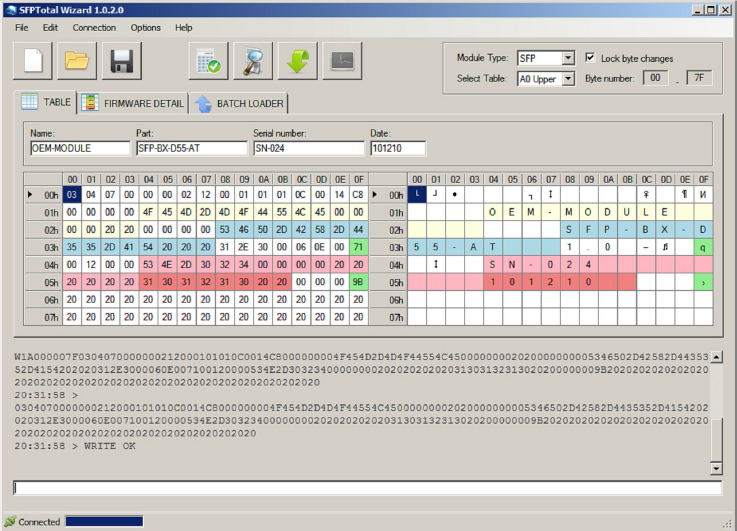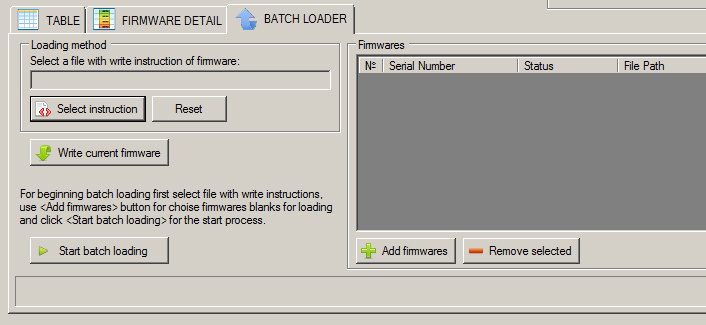Difference between revisions of "Write firmware to the transceiver's memory"
From SFPTotal Wiki
(→Programming using scripts) |
|||
| Line 3: | Line 3: | ||
* '''Programming using scripts''' for write-protected transceivers and transceivers with non-standart reprogramm algorithm. | * '''Programming using scripts''' for write-protected transceivers and transceivers with non-standart reprogramm algorithm. | ||
| − | == Programming according to MSA standards == | + | == Programming transceivers according to MSA standards == |
If transceiver supports writing the memory according to the MSA standards for the selected type of module, software sends a command to the programming board that implements the algorithm of writing into the memory. | If transceiver supports writing the memory according to the MSA standards for the selected type of module, software sends a command to the programming board that implements the algorithm of writing into the memory. | ||
| Line 30: | Line 30: | ||
:: [[File:SFPTotal Write firmware.jpg]] | :: [[File:SFPTotal Write firmware.jpg]] | ||
| − | == Programming using scripts == | + | == Programming transceivers using scripts == |
When the first option does not work for the selected transceiver, writing into memory is made with a special set of commands (scripts) that are sent to the programmer for a | When the first option does not work for the selected transceiver, writing into memory is made with a special set of commands (scripts) that are sent to the programmer for a | ||
Revision as of 16:08, 20 November 2015
Due to mismatch of the majority of the modules to the MSA standards because of installed special controllers or use non-standard ways of writing firmware into transceiver’s memory by the manufacturers, SFPTotal software implements two different approaches.
- Programming according to MSA standarts
- Programming using scripts for write-protected transceivers and transceivers with non-standart reprogramm algorithm.
Programming transceivers according to MSA standards
If transceiver supports writing the memory according to the MSA standards for the selected type of module, software sends a command to the programming board that implements the algorithm of writing into the memory.
To initiate the writing, you must:
- 1. Connect the PG series programmer to a computer and run the program SFPTotal Wizard, or just connect the device, if the program is already running.
- 2. Connect the transceiver to the programmer port.
- 3. Choose type of your transceiver (Module Type) and a memory table for reading (Select table).
- 4. Make sure that the tab TABLE contain the correct firmware for writing. Check the firmware checksum.
- 5. Press button for writing the transceivers memory.
- 6. After finishing the procedure of writing firmware, software will display a message in the history of operations executed by the command:
- WRITE OK - writing was successful,
- WRITE FAIL - the writing was unsuccessful
Programming transceivers using scripts
When the first option does not work for the selected transceiver, writing into memory is made with a special set of commands (scripts) that are sent to the programmer for a realization of custom writing algorithm, supported bytransceiver.
- 1. In the tab BATCH LOADER click to the button Select instruction to specify path to the file with algorithm of writing.
- 2. Make sure that the tab TABLE contain the correct firmware for writing. Check the firmware checksum.
- 3. Next step press button for writing the transceivers memory.
- You should pay attention to the fact that after implementation of that algorithm there is no software verification of the writing.
- If the writing was successful, the contents of the firmware in the Table will not be changed upon completion of the reading operation.
Notes
- The basic set of scripts for writing the firmware to the memory of the transceivers from different manufacturers is supplied with the program.



